Geospatial Multi-Criteria Approach for Ranking Suitable Shallow Aquifers for the Implementation of an On-Farm Solar-PV Desalination System for Sustainable Agriculture
Abstract
:1. Introduction
2. Materials and Methods
2.1. Study Area
2.2. Multi-Criteria Decision Analysis (MCDA)
2.2.1. Description of Problem
2.2.2. Identification of Alternatives
2.2.3. Selection of Decision-Making Criteria
2.2.4. Determination of Criteria Weights
2.2.5. Aggregation of Criteria
2.2.6. Sensitivity Analysis
2.2.7. Evaluating the Removal Influence of Evaporation and Photovoltaic Modules from SmaIrriCube Systems on Shallow Aquifers Ranking
2.3. Geospatial Analysis
2.3.1. Thematic Spatial Layers and Model Setup
2.3.2. Mapping Shallow Aquifers Suitability for SmaIrriCube System Installation
3. Results
3.1. Evaluation of Constraints
3.2. Evaluation of Main Criteria
3.3. Suitable Shallow Aquifers Ranking for SmaIrriCube Systems Implementation
3.4. Sensitivity Analysis
3.5. Evaluating the Removal Influence of Evaporation and Photovoltaic Modules from SmaIrriCube System on Shallow Aquifers Ranking
3.5.1. Suitable Shallow Aquifers Ranking for Scenarios SmaIrriCubeEff-E0 and SmaIrriCubeAcc-E0 Systems Implementation
3.5.2. Suitable Shallow Aquifer Ranking for Scenarios SmaIrriCubeEff-PV0 and SmaIrriCubeAcc-PV0 Systems Implementation
3.5.3. Suitable Shallow Aquifer Ranking for System Implementation for SmaIrriCubeEff-E0-PV0 and SmaIrriCubeAcc-E0-PV0 Scenarios
4. Discussion
5. Conclusions
Author Contributions
Funding
Institutional Review Board Statement
Informed Consent Statement
Data Availability Statement
Acknowledgments
Conflicts of Interest
Appendix A
| Criteria | Original Wi | −20% Wi | −10% Wi | +10% Wi | +20% Wi |
|---|---|---|---|---|---|
| Well density | 0.020 | 0.025 | 0.023 | 0.017 | 0.014 |
| Slope | 0.030 | 0.035 | 0.033 | 0.027 | 0.024 |
| Temperature | 0.040 | 0.045 | 0.042 | 0.037 | 0.034 |
| Evaporation | 0.178 | 0.139 | 0.158 | 0.198 | 0.218 |
| Agricultural area | 0.178 | 0.184 | 0.181 | 0.175 | 0.173 |
| Global horizontal irradiation | 0.178 | 0.184 | 0.181 | 0.175 | 0.173 |
| Groundwater quantity | 0.178 | 0.184 | 0.181 | 0.175 | 0.173 |
| Groundwater salinity | 0.198 | 0.204 | 0.201 | 0.195 | 0.192 |
| Total | 1.000 | 1.000 | 1.000 | 1.000 | 1.000 |
| Criteria | Original Wi | −20% Wi | −10% Wi | +10% Wi | +20% Wi |
|---|---|---|---|---|---|
| Well density | 0.020 | 0.025 | 0.023 | 0.017 | 0.014 |
| Slope | 0.030 | 0.035 | 0.033 | 0.027 | 0.024 |
| Temperature | 0.040 | 0.045 | 0.042 | 0.037 | 0.034 |
| Evaporation | 0.178 | 0.184 | 0.181 | 0.175 | 0.73 |
| Agricultural area | 0.178 | 0.139 | 0.158 | 0.198 | 0.218 |
| Global horizontal irradiation | 0.178 | 0.184 | 0.181 | 0.175 | 0.173 |
| Groundwater quantity | 0.178 | 0.184 | 0.181 | 0.175 | 0.173 |
| Groundwater salinity | 0.198 | 0.204 | 0.201 | 0.195 | 0.192 |
| Total | 1.000 | 1.000 | 1.000 | 1.000 | 1.000 |
| Criteria | Original Wi | −20% Wi | −10% Wi | +10% Wi | +20% Wi |
|---|---|---|---|---|---|
| Well density | 0.020 | 0.025 | 0.023 | 0.017 | 0.014 |
| Slope | 0.030 | 0.035 | 0.033 | 0.027 | 0.024 |
| Temperature | 0.040 | 0.045 | 0.042 | 0.037 | 0.034 |
| Evaporation | 0.178 | 0.184 | 0.181 | 0.175 | 0.173 |
| Agricultural area | 0.178 | 0.184 | 0.181 | 0.175 | 0.173 |
| Global horizontal irradiation | 0.178 | 0.139 | 0.158 | 0.198 | 0.218 |
| Groundwater quantity | 0.178 | 0.184 | 0.181 | 0.175 | 0.173 |
| Groundwater salinity | 0.198 | 0.204 | 0.201 | 0.195 | 0.192 |
| Total | 1.000 | 1.000 | 1.000 | 1.000 | 1.000 |
| Criteria | Original Wi | −20% Wi | −10% Wi | +10% Wi | +20% Wi |
|---|---|---|---|---|---|
| Well density | 0.020 | 0.025 | 0.023 | 0.017 | 0.014 |
| Slope | 0.030 | 0.035 | 0.033 | 0.027 | 0.024 |
| Temperature | 0.040 | 0.045 | 0.042 | 0.037 | 0.034 |
| Evaporation | 0.178 | 0.184 | 0.181 | 0.175 | 0.173 |
| Agricultural area | 0.178 | 0.184 | 0.181 | 0.175 | 0.173 |
| Global horizontal irradiation | 0.178 | 0.184 | 0.181 | 0.175 | 0.173 |
| Groundwater quantity | 0.178 | 0.139 | 0.158 | 0.198 | 0.218 |
| Groundwater salinity | 0.198 | 0.204 | 0.201 | 0.195 | 0.192 |
| Total | 1.000 | 1.000 | 1.000 | 1.000 | 1.000 |
| Criteria | Original Wi | −20% Wi | −10% Wi | +10% Wi | +20% Wi |
|---|---|---|---|---|---|
| Well density | 0.020 | 0.025 | 0.023 | 0.017 | 0.014 |
| Slope | 0.030 | 0.035 | 0.033 | 0.027 | 0.024 |
| Temperature | 0.040 | 0.045 | 0.042 | 0.037 | 0.034 |
| Evaporation | 0.178 | 0.184 | 0.181 | 0.175 | 0.173 |
| Agricultural area | 0.178 | 0.184 | 0.181 | 0.175 | 0.173 |
| Global horizontal irradiation | 0.178 | 0.184 | 0.181 | 0.175 | 0.173 |
| Groundwater quantity | 0.178 | 0.184 | 0.181 | 0.175 | 0.173 |
| Groundwater salinity | 0.198 | 0.158 | 0.178 | 0.218 | 0.238 |
| Total | 1.000 | 1.000 | 1.000 | 1.000 | 1.000 |
Appendix B
| Original Model | Sensitivity Analysis Scenarios | |||
|---|---|---|---|---|
| −20% Wi | −10% Wi | +10% Wi | +20% Wi | |
| SmaIrriCubeEff | 0.89 | 0.97 | 0.98 | 0.87 |
| SmaIrriCubeAcc | 0.90 | 0.99 | 1.00 | 0.89 |
| Original Model | Sensitivity Analysis Scenarios | |||
|---|---|---|---|---|
| −20% Wi | −10% Wi | +10% Wi | +20% Wi | |
| SmaIrriCubeEff | 0.89 | 0.95 | 0.99 | 0.93 |
| SmaIrriCubeAcc | 0.86 | 0.97 | 0.99 | 0.99 |
| Original Model | Sensitivity Analysis Scenarios | |||
|---|---|---|---|---|
| −20% Wi | −10% Wi | +10% Wi | +20% Wi | |
| SmaIrriCubeEff | 0.85 | 0.96 | 0.97 | 0.89 |
| SmaIrriCubeAcc | 0.98 | 0.90 | 0.99 | 0.94 |
| Original Model | Sensitivity Analysis Scenarios | |||
|---|---|---|---|---|
| −20% Wi | −10% Wi | +10% Wi | +20% Wi | |
| SmaIrriCubeEff | 0.88 | 0.97 | 0.98 | 0.86 |
| SmaIrriCubeAcc | 0.89 | 0.99 | 0.99 | 0.97 |
| Original Model | Sensitivity Analysis Scenarios | |||
|---|---|---|---|---|
| −20% Wi | −10% Wi | +10% Wi | +20% Wi | |
| SmaIrriCubeEff | 0.86 | 0.96 | 0.98 | 0.89 |
| SmaIrriCubeAcc | 0.87 | 0.98 | 0.99 | 0.90 |
References
- Water in Agriculture. Available online: https://www.worldbank.org/en/topic/water-in-agriculture#1 (accessed on 22 April 2022).
- Jakemann·, A.; Randall, O.; Huntt, J.; Andrewwross, J.-D. Integrated Groundwater Management Concepts, Approaches and Challenges; Springer Nature: Berlin, Germany, 2016. [Google Scholar]
- Achu, A.L.; Thomas, J.; Reghunath, R. Multi-Criteria Decision Analysis for Delineation of Groundwater Potential Zones in a Tropical River Basin Using Remote Sensing, GIS and Analytical Hierarchy Process (AHP). Groundw. Sustain. Dev. 2020, 10, 100365. [Google Scholar] [CrossRef]
- Awaad, H.A.; Mansour, E.; Akrami, M.; Fath, H.E.S.; Javadi, A.A.; Negm, A. Availability and Feasibility Ofwater Desalination as a Non-Conventional Resource for Agricultural Irrigation in the MENA Region: A Review. Sustainability 2020, 12, 7592. [Google Scholar] [CrossRef]
- Closas, A.; Molle, F. Groundwater Governance in MENA; IWMI: Gujarat, India, 2016. [Google Scholar]
- Mateo-Sagasta, J.; Burke, J. Agriculture and Water Quality Interactions: A Global Overview SOLAW TR08; FAO: Roma, Italy, 2011. [Google Scholar]
- Kumar, R.; Ahmed, M.; Bhadrachari, G.; Thomas, J.P. Desalination for Agriculture: Water Quality and Plant Chemistry, Technologies and Challenges. Water Sci. Technol. Water Supply 2018, 18, 1505–1517. [Google Scholar] [CrossRef] [Green Version]
- Burn, S.; Hoang, M.; Zarzo, D.; Olewniak, F.; Campos, E.; Bolto, B.; Barron, O. Desalination Techniques—A Review of the Opportunities for Desalination in Agriculture. Desalination 2015, 364, 2–16. [Google Scholar] [CrossRef]
- SmaCuMed—An Innovative Smart Irrigation Cube for Sustainable Agriculture. Available online: https://smacumed.eu/ (accessed on 20 April 2022).
- Belton, V.; Hodgkin, J. Facilitators, Decision Makers, D.I.Y. Users: Is Intelligent Multicriteria Decision Support for All Feasible or Desirable? Eur. J. Oper. Res. 1999, 113, 247–260. [Google Scholar] [CrossRef]
- Figueira, J.; Greco, S.; Ehrgott, M. Multiple Criteria Decision Analysis: State of the Art Surveys; Springer: New York, NY, USA, 2005; Volume 78, ISBN 0387230815. [Google Scholar]
- Dweiri, F.; Khan, S.A.; Almulla, A. A Multi-Criteria Decision Support System to Rank Sustainable Desalination Plant Location Criteria. Desalination 2018, 444, 26–34. [Google Scholar] [CrossRef]
- Dawoud, O.; Ahmed, T.; Abdel-Latif, M.; Abunada, Z. A Spatial Multi-Criteria Analysis Approach for Planning and Management of Community-Scale Desalination Plants. Desalination 2020, 485, 114426. [Google Scholar] [CrossRef]
- Sánchez-Lozano, J.M.; Teruel-Solano, J.; Soto-Elvira, P.L.; Socorro García-Cascales, M. Geographical Information Systems (GIS) and Multi-Criteria Decision Making (MCDM) Methods for the Evaluation of Solar Farms Locations: Case Study in South-Eastern Spain. Renew. Sustain. Energy Rev. 2013, 24, 544–556. [Google Scholar] [CrossRef]
- Aydin, F.; Sarptas, H. Spatial Assessment of Site Suitability for Solar Desalination Plants: A Case Study of the Coastal Regions of Turkey. Clean Technol. Environ. Policy 2020, 22, 309–323. [Google Scholar] [CrossRef]
- Yunna, W.; Geng, S. Multi-Criteria Decision Making on Selection of Solar-Wind Hybrid Power Station Location: A Case of China. Energy Convers. Manag. 2014, 81, 527–533. [Google Scholar] [CrossRef]
- Vagiona, D.G. Comparative Multicriteria Analysis Methods for Ranking Sites for Solar Farm Deployment: A Case Study in Greece. Energies 2021, 14, 8371. [Google Scholar] [CrossRef]
- Charabi, Y.; Gastli, A. PV Site Suitability Analysis Using GIS-Based Spatial Fuzzy Multi-Criteria Evaluation. Renew. Energy 2011, 36, 2554–2561. [Google Scholar] [CrossRef]
- Grubert, E.A.; Stillwell, A.S.; Webber, M.E. Where Does Solar-Aided Seawater Desalination Make Sense? A Method for Identifying Sustainable Sites. Desalination 2014, 339, 10–17. [Google Scholar] [CrossRef] [Green Version]
- Mostafaeipour, A.; Saidi-Mehrabad, M.; Rezaei, M.; Qolipour, M. The Ranking of Southern Ports and Islands of Iran for Seawater Desalination Plants Using ELECTRE III Method. J. Renew. Energy Environ. 2017, 4, 10–22. [Google Scholar]
- Mostafaeipour, A.; Mohammadi, S.M.; Najafi, F.; Issakhov, A. Investigation of Implementing Solar Energy for Groundwater Desalination in Arid and Dry Regions: A Case Study. Desalination 2021, 512, 115039. [Google Scholar] [CrossRef]
- Paktinat, H.; Faraji, H.A.; Kian, A.R. Solar Desalination Plant Site Suitability through Composing Decision-Making Systems and Fuzzy Logic in Iran (Using the Desert Areas Approach). Desert 2014, 19, 111–119. [Google Scholar]
- Tunisia—Summary|Climate Change Knowledge Portal. Available online: https://climateknowledgeportal.worldbank.org/country/tunisia (accessed on 20 April 2022).
- FAO. Water Productivity. Available online: https://wapor.apps.fao.org/home/WAPOR_2/1 (accessed on 20 April 2022).
- MARHP. Rapport National Du Secteur De L’eau. 2017. Available online: http://www.onagri.nat.tn/uploads/statistiques/PRINT-2019%20Secteur-eau.pdf (accessed on 12 May 2022).
- Closas, A.; Imache, A.; Mekki, I. Groundwater Governance in Tunisia—A Policy White Paper; USAID: Washington, DC, USA; IWMI: Gujara, India, 2017. [Google Scholar]
- Sánchez-Lozano, J.M.; García-Cascales, M.S.; Lamata, M.T. Evaluation of Suitable Locations for the Installation of Solar Thermoelectric Power Plants. Comput. Ind. Eng. 2015, 87, 343–355. [Google Scholar] [CrossRef]
- Sánchez-Lozano, J.M.; García-Cascales, M.S.; Lamata, M.T. Comparative TOPSIS-ELECTRE TRI Methods for Optimal Sites for Photovoltaic Solar Farms. Case Study Spain. J. Clean. Prod. 2016, 127, 387–398. [Google Scholar] [CrossRef]
- Alami Merrouni, A.; Elwali Elalaoui, F.; Mezrhab, A.; Mezrhab, A.; Ghennioui, A. Large Scale PV Sites Selection by Combining GIS and Analytical Hierarchy Process. Case Study: Eastern Morocco. Renew. Energy 2018, 119, 863–873. [Google Scholar] [CrossRef]
- Al Garni, H.Z.; Awasthi, A. Solar PV Power Plant Site Selection Using a GIS-AHP Based Approach with Application in Saudi Arabia. Appl. Energy 2017, 206, 1225–1240. [Google Scholar] [CrossRef]
- Aldababseh, A.; Temimi, M.; Maghelal, P.; Branch, O.; Wulfmeyer, V. Multi-Criteria Evaluation of Irrigated Agriculture Suitability to Achieve Food Security in an Arid Environment. Sustainability 2018, 10, 803. [Google Scholar] [CrossRef] [Green Version]
- Sayed, E.; Riad, P.; Elbeih, S.; Hagras, M.; Hassan, A.A. Multi Criteria Analysis for Groundwater Management Using Solar Energy in Moghra Oasis, Egypt. Egypt. J. Remote Sens. Space Sci. 2019, 22, 227–235. [Google Scholar] [CrossRef]
- Afify, A. Prioritizing Desalination Strategies Using Multi-Criteria Decision Analysis. Desalination 2010, 250, 928–935. [Google Scholar] [CrossRef]
- Lenntech. Brine Evaporation Ponds. Available online: www.lenntech.com/processes/brine-evaporation-ponds.htm#ixzz6nSrr81V7 (accessed on 9 November 2021).
- Sánchez-Lozano, J.M.; Henggeler Antunes, C.; García-Cascales, M.S.; Dias, L.C. GIS-Based Photovoltaic Solar Farms Site Selection Using ELECTRE-TRI: Evaluating the Case for Torre Pacheco, Murcia, Southeast of Spain. Renew. Energy 2014, 66, 478–494. [Google Scholar] [CrossRef]
- Lee, A.H.I.; Kang, H.Y.; Lin, C.Y.; Shen, K.C. An Integrated Decision-Making Model for the Location of a PV Solar Plant. Sustainability 2015, 7, 13522–13541. [Google Scholar] [CrossRef] [Green Version]
- Liu, J.; Xu, F.; Lin, S. Site Selection of Photovoltaic Power Plants in a Value Chain Based on Grey Cumulative Prospect Theory for Sustainability: A Case Study in Northwest China. J. Clean. Prod. 2017, 148, 386–397. [Google Scholar] [CrossRef]
- Ahmed, M.; Shayyab, W.H.; Hoey, D.; Al-Handaly, J. Brine Disposal from Reverse Osmosis Desalination Oman and the United Arab Emirates; Elsevier: Amsterdam, The Netherlands, 2001; Volume 133. [Google Scholar]
- Ahmed, M.; Shayya, W.H.; Hoey, D.; Al-Handaly, J. Brine Disposal from Inland Desalination Plants Research Needs Assessment. Water International 2002, 27, 194–201. [Google Scholar] [CrossRef]
- Banat, F.; Subiela, V.; Qiblawey, H. Site Selection for the Installation of Autonomous Desalination Systems (ADS). Desalination 2007, 203, 410–416. [Google Scholar] [CrossRef]
- Mohamed, S.A. Application of Geo-Spatial Analytical Hierarchy Process and Multi-Criteria Analysis for Site Suitability of the Desalination Solar Stations in Egypt. J. Afr. Earth Sci. 2020, 164, 103767. [Google Scholar] [CrossRef]
- Salim, M.G. Selection of Groundwater Sites in Egypt, Using Geographic Information Systems, for Desalination by Solar Energy in Order to Reduce Greenhouse Gases. J. Adv. Res. 2012, 3, 11–19. [Google Scholar] [CrossRef] [Green Version]
- Perpiña Castillo, C.; Batista e Silva, F.; Lavalle, C. An Assessment of the Regional Potential for Solar Power Generation in EU-28. Energy Policy 2016, 88, 86–99. [Google Scholar] [CrossRef]
- Edwards, W.; Barron, F.H. SMARTS and SMARTER: Improved Simple Methods for Multi-Attribute Utility Measurement. Organ. Behav. Hum. Decis. Processes 1994, 60, 306–325. [Google Scholar] [CrossRef]
- Alinezhad, A.; Khalili, J. International Series in Operations Research & Management Science New Methods and Applications in Multiple Attribute Decision Making (MADM); Springer: Berlin/Heidelberg, Germany, 2019; Volume 277. [Google Scholar]
- Çelen, A. Comparative Analysis of Normalization Procedures in TOPSIS Method: With an Application to Turkish Deposit Banking Market. Informatica 2014, 25, 185–208. [Google Scholar] [CrossRef] [Green Version]
- Triantaphyllou, E. Multi-Criteria Decision Making Methods: A Comparative Study; Springer: Boston, MA, USA, 2000; pp. 5–21. [Google Scholar]
- Triantaphyllou, E.; Sánchez, A. A Sensitivity Analysis Approach for Some Deterministic Multi-Criteria Decision-Making Methods. Decis. Sci. 1997, 28, 151–194. [Google Scholar] [CrossRef]
- Saltelli, A.; Ratto, M.; Andres, T.; Campolongo, F.; Cariboni, J.; Gatelli, D.; Salsana, M.; Tarantola, S. Global Sensitivity Analysis: The Primer; Wiley: Hoboken, NJ, USA, 2008. [Google Scholar]
- Kottegoda, N.T.; Rosso, R. Statistics, Probability, and Reliability for Civil and Environmental Engineers, 2nd ed.; McGraw-Hill: Singapore, 1997. [Google Scholar]
- EarthExplorer. Available online: https://earthexplorer.usgs.gov/ (accessed on 22 April 2022).
- Global Solar Atlas. Available online: https://globalsolaratlas.info/map?c=11.609193,8.4375,3 (accessed on 22 April 2022).
- Direction Génerale des Ressources en Eau (DGRE). (Ouagadougou, Burkina Faso). Situation de l’exploitation Des Nappes Phréatiques. Unpublished work. 2015. [Google Scholar]
- Zarzo, D.; Campos, E.; Terrero, P. Spanish Experience in Desalination for Agriculture. Desalination Water Treat. 2013, 51, 53–66. [Google Scholar] [CrossRef]
- Katal, R.; Ying Shen, T.; Jafari, I.; Masudy-Panah, S.; Hossein Davood Abadi Farahani, M. An Overview on the Treatment and Management of the Desalination Brine Solution. In Desalination—Challenges and Opportunities; IntechOpen: London, UK, 2020. [Google Scholar]
- Soliman, M.N.; Guen, F.Z.; Ahmed, S.A.; Saleem, H.; Khalil, M.J.; Zaidi, S.J. Energy Consumption and Environmental Impact Assessment of Desalination Plants and Brine Disposal Strategies. Process Saf. Environ. Prot. 2021, 147, 589–608. [Google Scholar] [CrossRef]
- Jenkins, S.; Paduan, J.; Roberts, P.; Schlenk, D.; Weis, J. Management of Brine Discharges to Coastal Waters Recommendations of a Science Advisory Panel Panel Members. Available online: https://www.waterboards.ca.gov/water_issues/programs/ocean/desalination/docs/dpr051812.pdf (accessed on 12 May 2022).
- Abualtayef, M.; Al-Najjar, H.; Mogheir, Y.; Seif, A.K. Numerical Modeling of Brine Disposal from Gaza Central Seawater Desalination Plant. Arab. J. Geosci. 2016, 9, 1–18. [Google Scholar] [CrossRef]

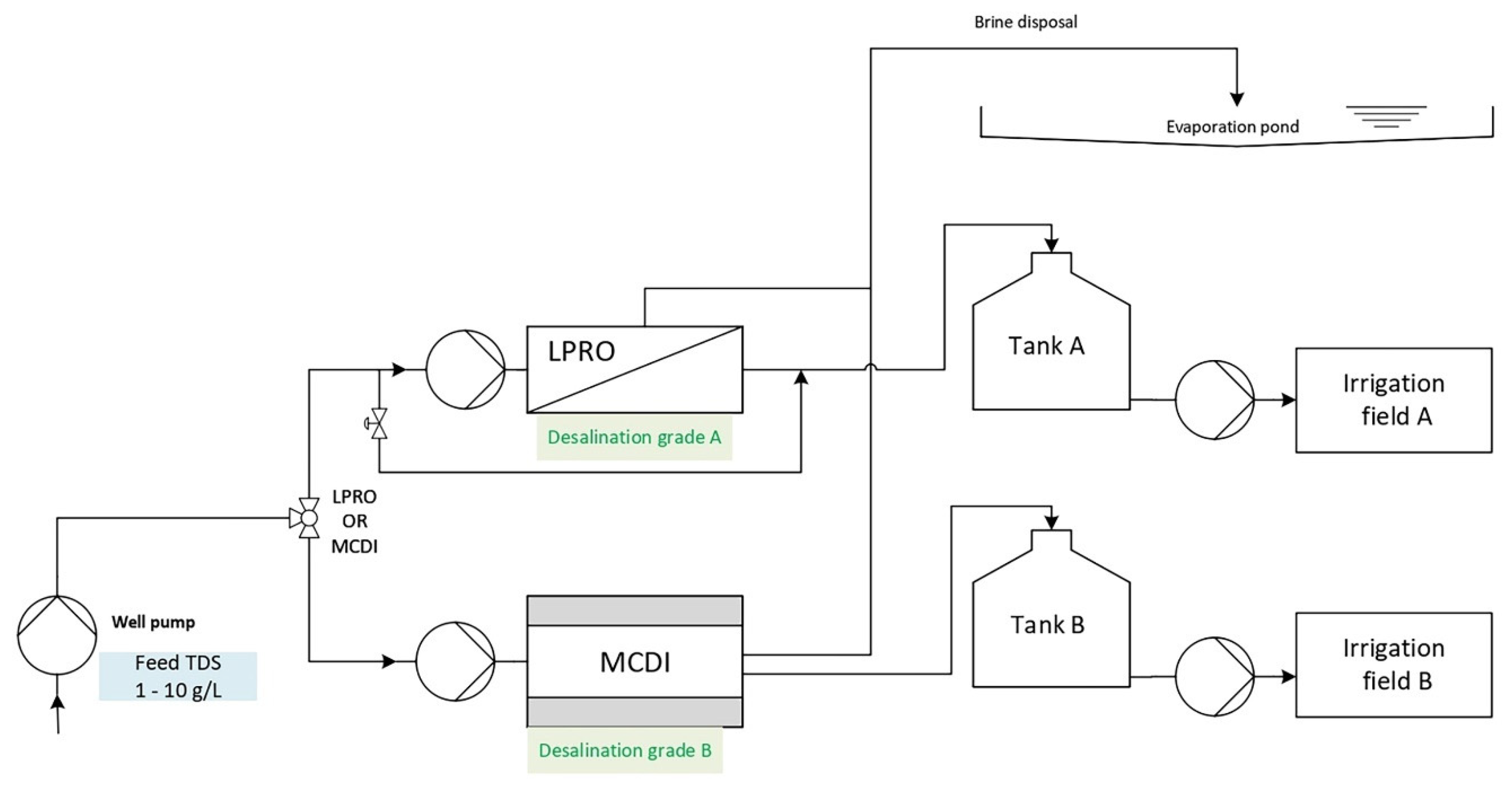
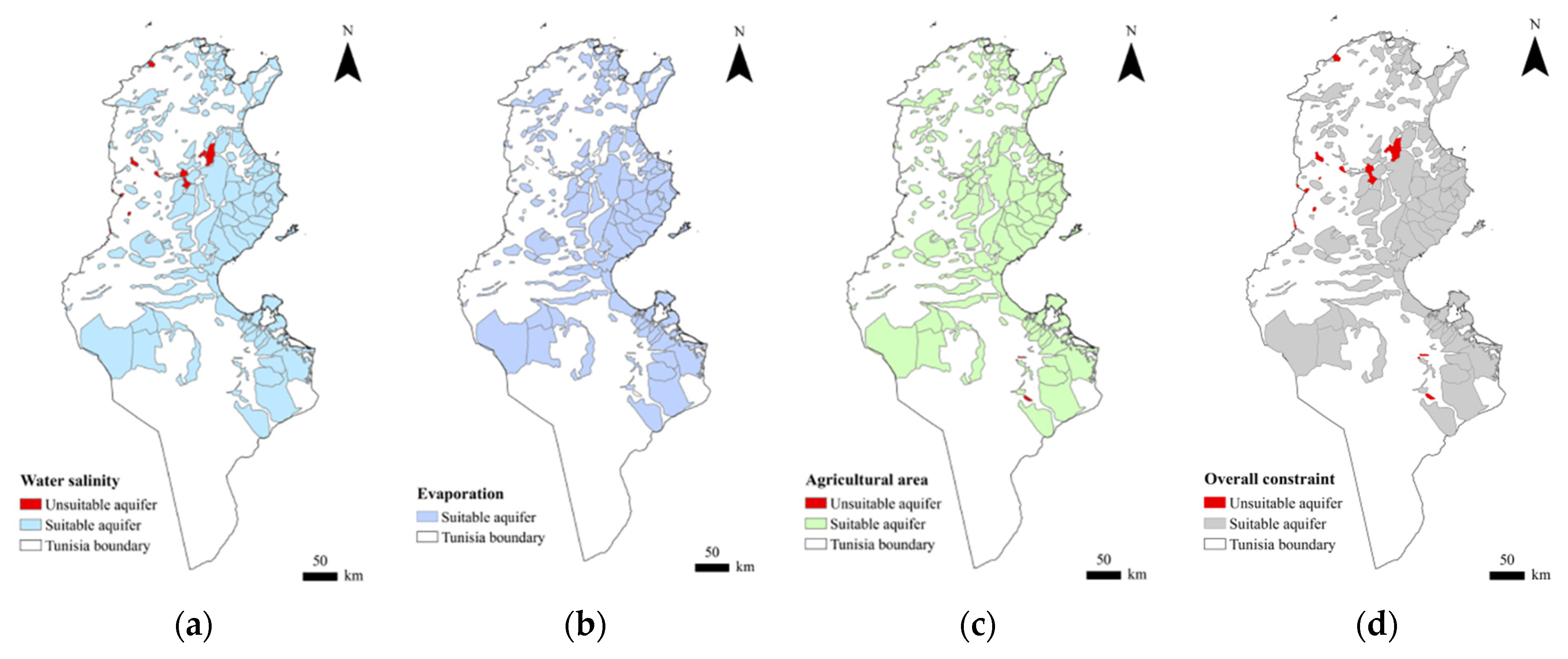
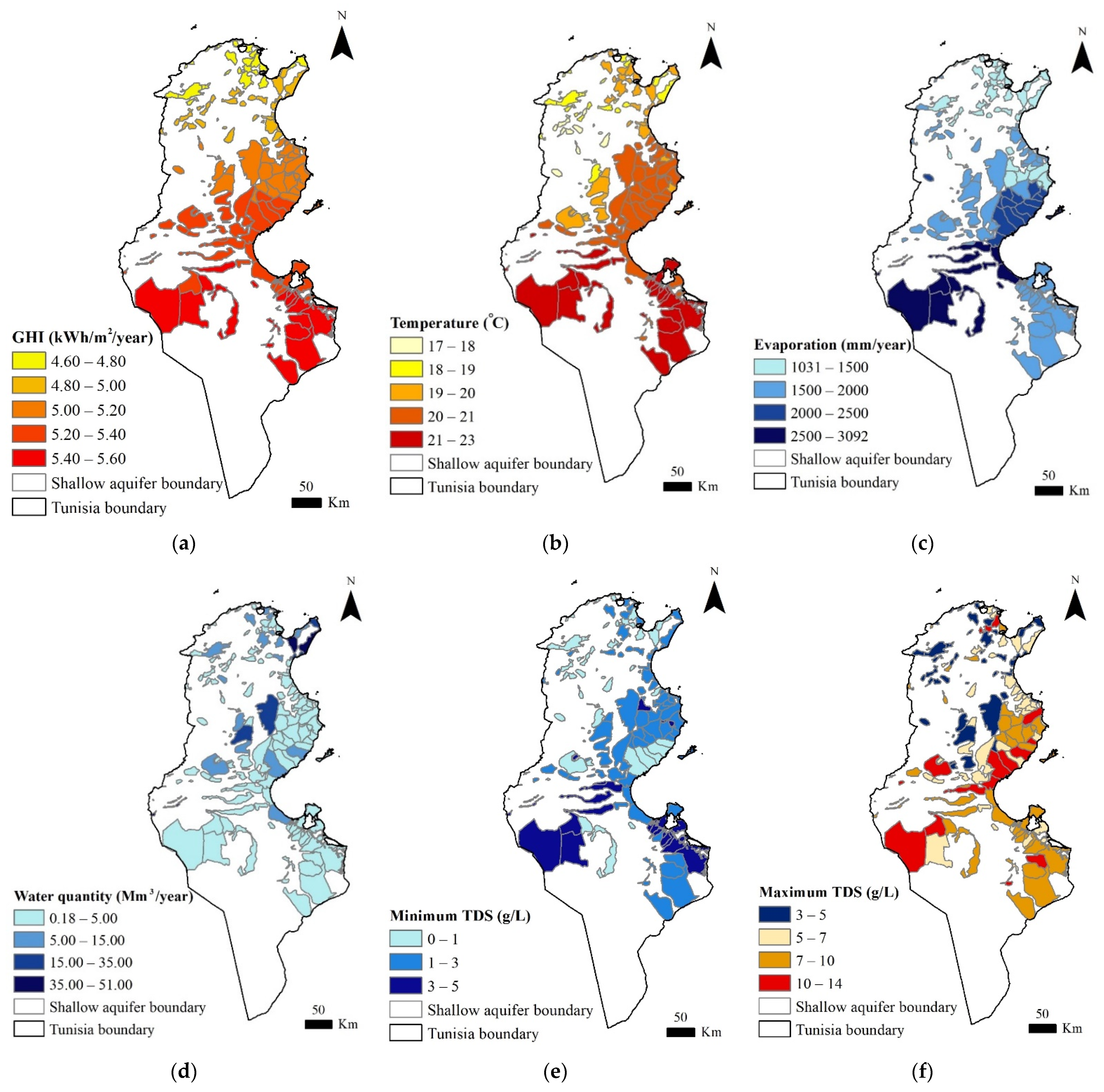

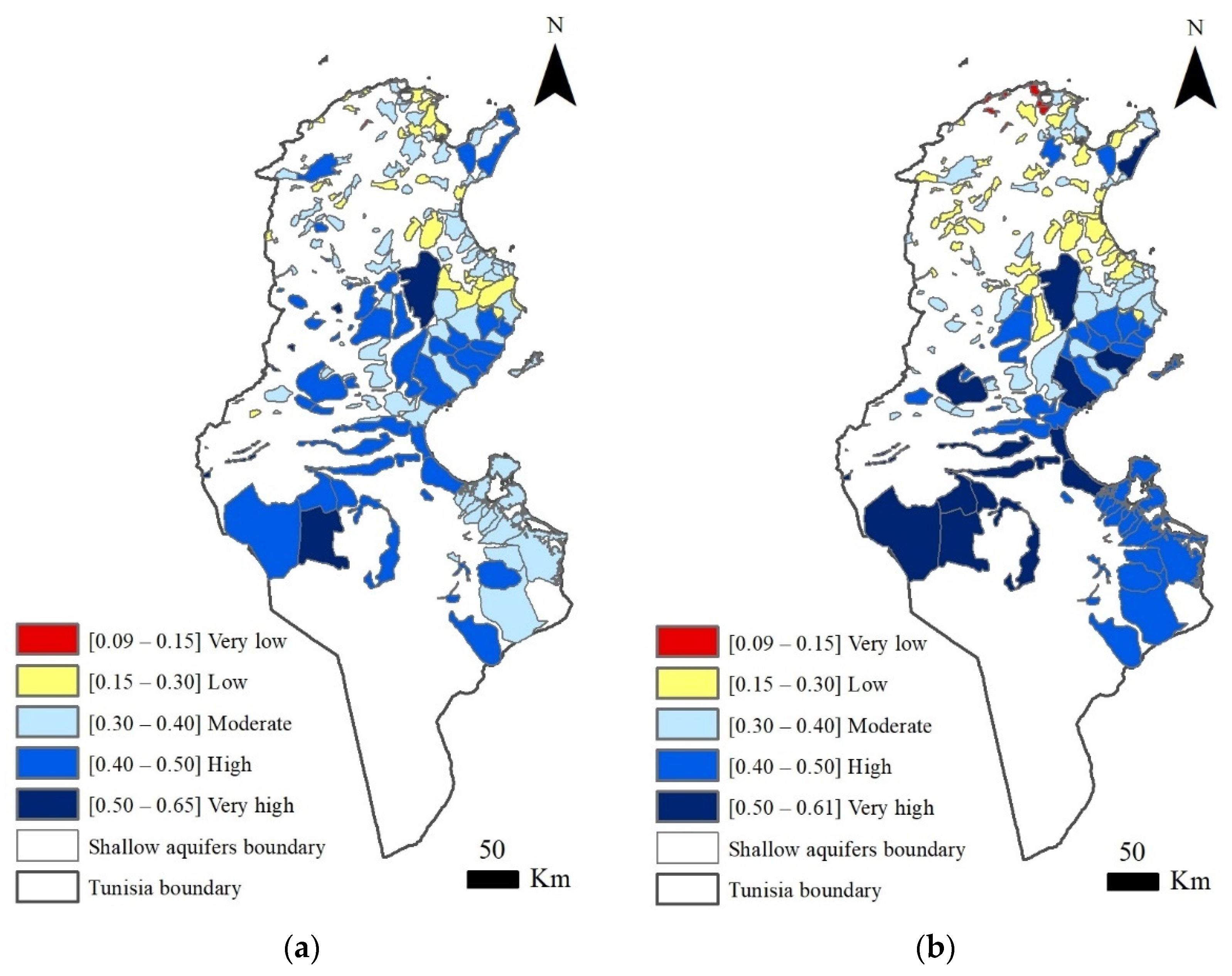
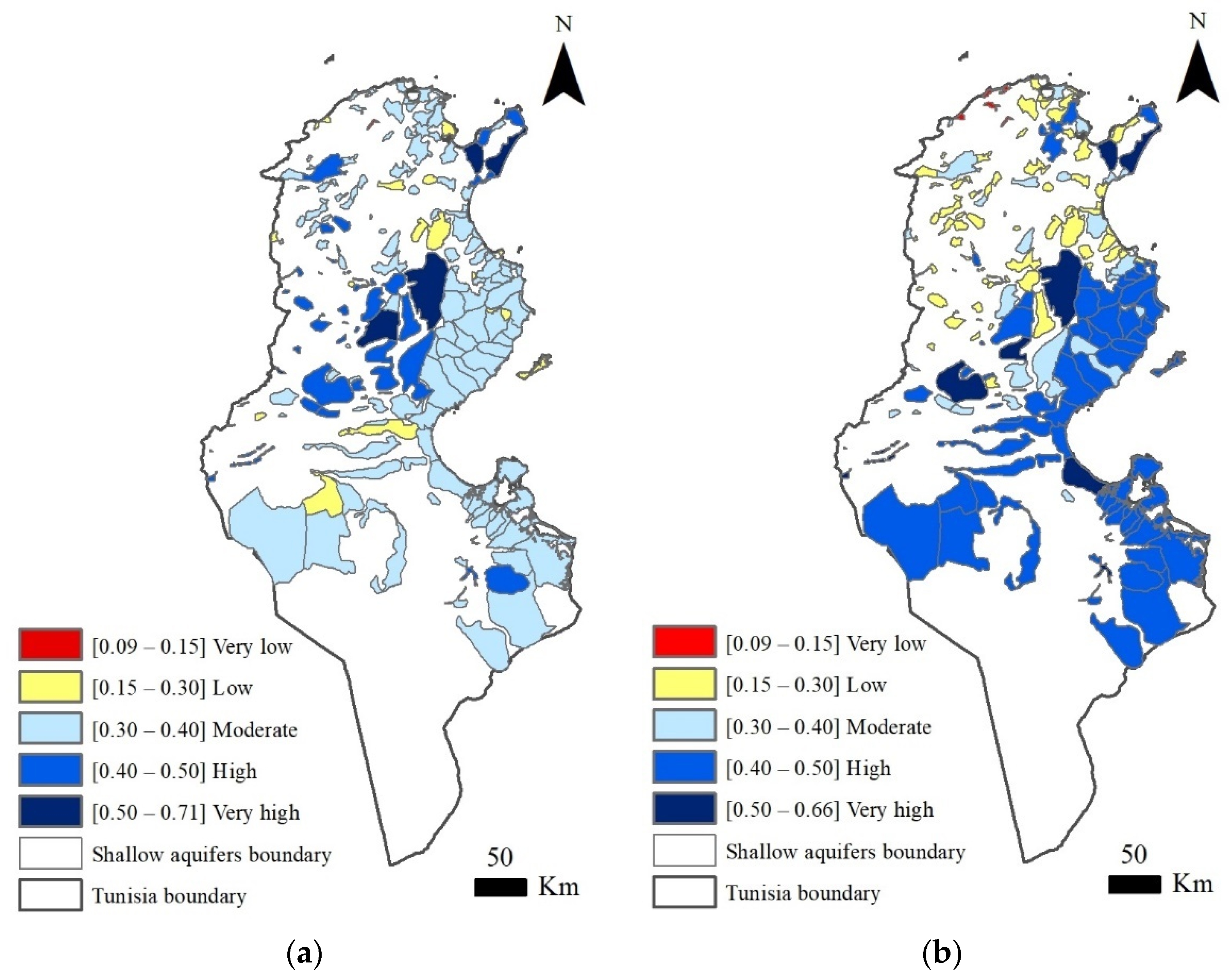

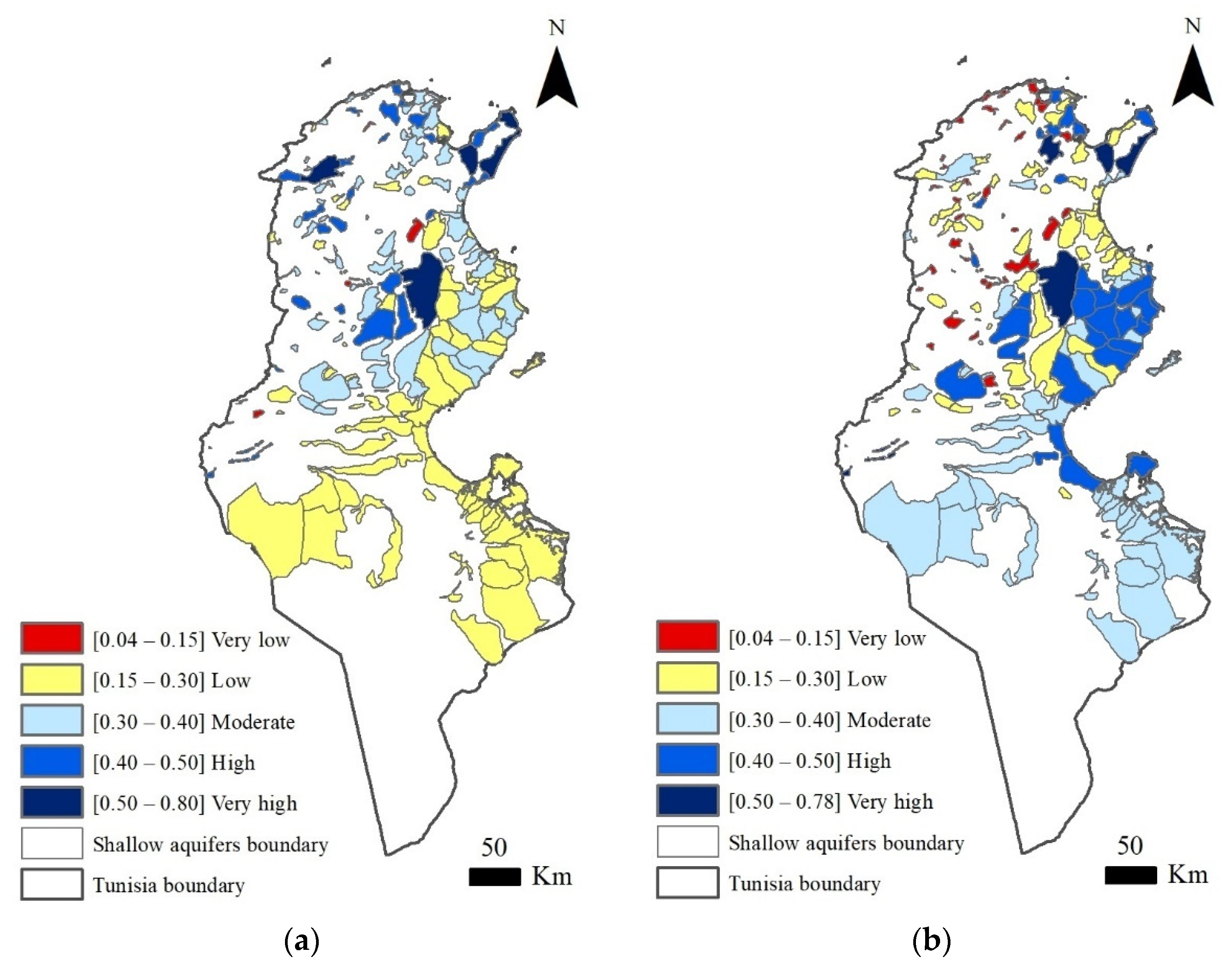
| Category | ID | Criteria | Unit | Justification | References |
|---|---|---|---|---|---|
| Climate | C1 | Global Horizontal Irradiation | kWh/m2/year | The Global Horizontal Irradiation (GHI) is the total solar radiation incident on a horizontal surface. It can be converted into sustainable-produced electricity by using photovoltaic (PV) technology. Higher radiation levels increase the electrical energy produced by the system. Thus, the higher the GHI, the better the electricity production will be. | [28,30,32,42,43] |
| C2 | Temperature | °C | Solar PV panel efficiency is affected negatively by the increase in the atmospheric temperature. The more sunshine a panel receives, the hotter the panel gets, and thus the conversion efficiency decreases. Furthermore, high temperature values affect the module’s lifetime and durability. | [28,30,36,37] | |
| C3 | Evaporation rate | Mm/year | Evaporation is the most important climate factor for brine evaporation. The evaporation process of brine increases with the increase in the evaporation rate. | [38,39] | |
| Water resources | C4 | Groundwater quantity | Mm3/year | Desalination technology is suitable for use where the volume of brackish groundwater is available and renewable, providing sufficient quantities for desalination plants and safeguarding its continuous operation. | [40] |
| C5 | Groundwater salinity | g/L | Groundwater salinity is one of the most critical water quality criteria. An aquifer with low salinity has the highest suitability for water desalination, and the suitability decreases with the increase in the salinity level. | [19,31,32,33,42] | |
| C6 | Well density | Well density per aquifer is an economic factor to avoid the high cost of constructing and maintaining a new well. It is more cost-effective to use existing well water for desalination. An aquifer with the highest well density has the highest suitability, and the suitability decreases with the decrease in the well density. | [40] | ||
| Land Use | C7 | Agricultural areas | ha | The brackish groundwater desalination process in our study is intended for agricultural applications. Thus, areas of high agricultural use are more suitable to host the SmaIrriCube system. | [30] |
| Topography | C8 | Land slope | % | The SmaIrriCube system is highly affected by land slope. Slopes affect the feasibility of the system and increase investment costs. In general, areas with low land slope are considered the most suitable to minimize financial expenditure. | [30,31,38,39,40] |
| Criteria | Ii | Wi |
|---|---|---|
| Well density | 10 | 0.020 |
| Slope | 15 | 0.030 |
| Temperature | 20 | 0.040 |
| Evaporation | 90 | 0.178 |
| Agricultural area | 90 | 0.178 |
| Global horizontal irradiation | 90 | 0.178 |
| Groundwater quantity | 90 | 0.178 |
| Groundwater salinity | 100 | 0.198 |
| Total | 505 | 1.000 |
| Criteria | Scenario 1 | Scenario 2 | Scenario 3 | |||
|---|---|---|---|---|---|---|
| Pi | Wi | Pi | Wi | Pi | Wi | |
| Well density | 10 | 0.02 | 10 | 0.03 | 10 | 0.03 |
| Slope | 15 | 0.04 | 15 | 0.04 | 15 | 0.05 |
| Temperature | 20 | 0.05 | 0 | - | 0 | - |
| Evaporation | 0 | - | 90 | 0.23 | 0 | - |
| Agricultural area | 90 | 0.22 | 90 | 0.23 | 90 | 0.30 |
| GHI | 90 | 0.22 | 0 | - | 0 | - |
| Groundwater quantity | 90 | 0.22 | 90 | 0.23 | 90 | 0.30 |
| Groundwater salinity | 100 | 0.24 | 100 | 0.25 | 100 | 0.33 |
| Total | 415 | 1.00 | 395 | 1.00 | 305 | 1.00 |
| Data | Data Source | Extracted Data | Acquisition Date |
|---|---|---|---|
| SRTM DEM | Earthexplorer.usgs.gov (accessed on 20 July 2021) | Slope | |
| Satellite data | Globalsolaratlas.info (accessed on 22 July 2021) | Global horizontal irradiation | 1994 to 2018 |
| Temperature | 1994 to 2018 | ||
| Wapor.apps.fao.org (accessed on 22 July 2021) | LULC | 2019 | |
| Agricultural Map | MARHP | Well density | |
| Statistical data | DGRE report | Groundwater quantity | 2015 |
| Groundwater salinity | 2015 | ||
| INM | Evaporation | 2010–2020 |
| Rank | Shallow Aquifer_Name | Si | Performance Matrix | |||||||
|---|---|---|---|---|---|---|---|---|---|---|
| C1 | C2 | C3 | C4 | C5 | C6 | C7 | C8 | |||
| SmaIrriCubeEff | ||||||||||
| Best ranked aquifers | Kairouan Plain (Kairouan) | 0.65 | 5.05 | 20.01 | 1819.40 | 26.00 | [1.5–3.9] | 0.04 | 112,659 | 3.65 |
| Djerid Oasis (Tozeur) | 0.53 | 5.36 | 22.76 | 2526.00 | 36.00 | [4.0–7.0] | 0.21 | 2909 | 2.94 | |
| Oum Laksab (Gafsa-Kasserine) | 0.52 | 5.34 | 18.18 | 2142.82 | 8.30 | [1.0–2.0] | 0.13 | 627 | 3.92 | |
| Ain el Kerma (Tozeur) | 0.52 | 5.40 | 21.00 | 2526.00 | 4.55 | [1.5–3.5] | 0.48 | 43 | 5.36 | |
| Kasserine Plain (Kasserine) | 0.51 | 5.10 | 17.28 | 2392.90 | 1.44 | [1.0–1.5] | 0.73 | 137 | 3.23 | |
| Worst ranked aquifers | Hencha (Sfax-Mahdia) | 0.21 | 5.10 | 20.08 | 1031.3 | 1.5 | [5.0–7.0] | 0.02 | 6985 | 3.52 |
| Ain Bou Mourra (Kairouan) | 0.21 | 4.96 | 18.67 | 1819.4 | 2.0 | [0.0–1.2] | 0.02 | 8452 | 6.20 | |
| Haut-Joumine (Bizerte) | 0.09 | 4.68 | 17.91 | 1220 | 2.0 | [0.5–1.5] | 0.09 | 2800 | 20.34 | |
| SmaIrriCubeAcc | ||||||||||
| Best ranked aquifers | Djerid Oasis (Tozeur) | 0.61 | 5.36 | 22.76 | 2526 | 36.00 | [4.0–7.0] | 0.23 | 2909 | 2.94 |
| Nefzaoua Southern (Kebili) | 0.57 | 5.48 | 22.09 | 3092.30 | 0.63 | [4.0–6.5] | 0.00003 | 782 | 4.89 | |
| Gabes South (Gabes) | 0.56 | 5.35 | 20.89 | 2757.10 | 9.00 | [2.5–7.0] | 0.02 | 14,342 | 3.86 | |
| Nefzaoua Eastern (Kebili) | 0.56 | 5.51 | 21.80 | 3092.30 | 0.47 | [0.4–6.8] | 0.0001 | 422 | 4.54 | |
| Eastern Coast (Nabeul) | 0.56 | 4.83 | 18.92 | 1238.80 | 50.00 | [1.5–7.0] | 0.18 | 40,378 | 4.43 | |
| Worst ranked aquifers | Oeud Sejnane (Bizerte) | 0.13 | 4.61 | 18.65 | 1220 | 2.90 | [1.0–1.5] | 0.13 | 4444 | 5.42 |
| Kef Abed (Bizerte) | 0.12 | 4.62 | 19.12 | 1220 | 1.00 | [1.0–3.0] | 0.03 | 5862 | 8.87 | |
| Haut-Joumine (Bizerte) | 0.09 | 4.68 | 17.91 | 1220 | 2.00 | [0.5–1.5] | 0.09 | 2800 | 20.34 | |
| Rank | SmaIrriCubeEff-E0 | SmaIrriCubeAcc-E0 | ||
|---|---|---|---|---|
| Shallow Aquifer Name | Si | Shallow Aquifer Name | Si | |
| Best ranked aquifers | Kairouan Plain (Kairouan) | 0.71 | Eastern Coast (Nabeul) | 0.66 |
| Grombalia (Nabeul) | 0.58 | Djerid Oasis (Tozeur) | 0.59 | |
| Eastern Coast (Nabeul) | 0.57 | Kairouan Plain (Kairouan) | 0.56 | |
| Oum Laksab (Gafsa-Kasserine) | 0.51 | Gafsa North (Gafsa) | 0.53 | |
| Upstream Sidi Bouzid (Sidi Bouzid) | 0.51 | Grombalia (Tataouin) | 0.52 | |
| Worst ranked aquifers | El Bouajer (Kasserine) | 0.18 | Meknas-Barkoukech (Jandouba) | 0.14 |
| Ain Bou Mourra (Kasserine) | 0.17 | Kef Abed (Bizerte) | 0.13 | |
| Haute Joumine (Bizerte) | 0.09 | Haut Joumine (Bizerte) | 0.09 | |
| Rank | SmaIrriCubeEff-PV0 | SmaIrriCubeAcc-PV0 | ||
|---|---|---|---|---|
| Shallow Aquifer Name | Si | Shallow Aquifer Name | Si | |
| Best ranked aquifers | Kairouan Plain (Kairouan) | 0.70 | Eastern Coast (Nabeul) | 0.62 |
| Grombalia (Nabeul) | 0.55 | Djerid Oasis (Tozeur) | 0.61 | |
| Eastern Coast (Nabeul) | 0.53 | Kairouan Plain (Kairouan) | 0.54 | |
| Djerid Oasis (Tozeur) | 0.49 | Gabes south (Gabes) | 0.53 | |
| Kasserine plain (Kasserine) | 0.49 | Nefzaoua Southern (Kebili) | 0.52 | |
| Worst ranked aquifers | Ain Bou Mourra (Kasserine) | 0.15 | Oeud B. Hassine (Bizerte) | 0.11 |
| Hencha (Sfax-Mahdia) | 0.13 | Kef Abed (Bizerte) | 0.11 | |
| Haute Joumine (Bizerte) | 0.05 | Haut Joumine (Bizerte) | 0.05 | |
| Rank | SmaIrriCubeEff-E0-PV0 | SmaIrriCubeAcc-E0-PV0 | ||
|---|---|---|---|---|
| Shallow Aquifer Name | Si | Shallow Aquifer Name | Si | |
| Best ranked aquifers | Kairouan Plain (Kairouan) | 0.80 | Eastern Coast (Nabeul) | 0.78 |
| Grombalia (Nabeul) | 0.68 | Grombalia (Nabeul) | 0.59 | |
| Eastern Coast (Nabeul) | 0.66 | Kairouan Plain (Kairouan) | 0.59 | |
| Middle valley of Medjerda (Jandouba-Baja) | 0.55 | Oasis of Djerid (Tozeur) | 0.57 | |
| El Haouaria Plain (Nabeul) | 0.54 | Oeud Chafrou (Manouba) | 0.51 | |
| Worst ranked aquifers | Ain Bou Mourra (Kasserine) | 0.15 | Ain Bou Mourra (Kairouan) | 0.07 |
| El Bouajer (Kasserine) | 0.13 | El Bouajer (Kasserine) | 0.05 | |
| Haute Joumine (Bizerte) | 0.05 | Haut Joumine (Bizerte) | 0.04 | |
Publisher’s Note: MDPI stays neutral with regard to jurisdictional claims in published maps and institutional affiliations. |
© 2022 by the authors. Licensee MDPI, Basel, Switzerland. This article is an open access article distributed under the terms and conditions of the Creative Commons Attribution (CC BY) license (https://creativecommons.org/licenses/by/4.0/).
Share and Cite
Mehdaoui, R.; Anane, M.; Cañas Kurz, E.E.; Hellriegel, U.; Hoinkis, J. Geospatial Multi-Criteria Approach for Ranking Suitable Shallow Aquifers for the Implementation of an On-Farm Solar-PV Desalination System for Sustainable Agriculture. Sustainability 2022, 14, 8113. https://doi.org/10.3390/su14138113
Mehdaoui R, Anane M, Cañas Kurz EE, Hellriegel U, Hoinkis J. Geospatial Multi-Criteria Approach for Ranking Suitable Shallow Aquifers for the Implementation of an On-Farm Solar-PV Desalination System for Sustainable Agriculture. Sustainability. 2022; 14(13):8113. https://doi.org/10.3390/su14138113
Chicago/Turabian StyleMehdaoui, Rim, Makram Anane, Edgardo E. Cañas Kurz, Ulrich Hellriegel, and Jan Hoinkis. 2022. "Geospatial Multi-Criteria Approach for Ranking Suitable Shallow Aquifers for the Implementation of an On-Farm Solar-PV Desalination System for Sustainable Agriculture" Sustainability 14, no. 13: 8113. https://doi.org/10.3390/su14138113
APA StyleMehdaoui, R., Anane, M., Cañas Kurz, E. E., Hellriegel, U., & Hoinkis, J. (2022). Geospatial Multi-Criteria Approach for Ranking Suitable Shallow Aquifers for the Implementation of an On-Farm Solar-PV Desalination System for Sustainable Agriculture. Sustainability, 14(13), 8113. https://doi.org/10.3390/su14138113






